What Is A Registered Blue And Silvler Stamp
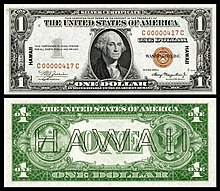
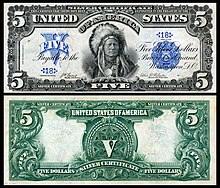
Silver certificates are a type of representative coin issued betwixt 1878 and 1964 in the United States as role of its circulation of newspaper currency.[1] They were produced in response to silver agitation by citizens who were angered by the 4th Coinage Act, which had effectively placed the United States on a gold standard.[ii] The certificates were initially redeemable for their face value of silver dollar coins and after (for one year – June 24, 1967 to June 24, 1968) in raw silverish bullion.[1] Since 1968 they have been redeemable but in Federal Reserve Notes and are thus obsolete, but still valid legal tender at their confront value and thus are all the same an accustomed class of currency.[ane]
Large-size silverish certificates (1878 to 1923)[nb 1] were issued initially in denominations from $x to $one,000 (in 1878 and 1880)[4] [5] and in 1886 the $one, $2, and $five were authorized.[5] [6] In 1928, all Us depository financial institution notes were re-designed and the size reduced.[vii] The small-scale-size silver certificate (1928–1964) was simply regularly issued in denominations of $1, $five, and $10.[viii] The consummate type set below is part of the National Numismatic Collection at the Smithsonian's National Museum of American History.
History [edit]
The Coinage Human action of 1873 intentionally[ix] [x] omitted language authorizing the coinage of "standard"[2] silver dollars[eleven] and ended the bimetallic standard[12] that had been created by Alexander Hamilton.[13] [nb 2] While the Coinage Act of 1873 stopped production of silver dollars, it was the 1874 adoption of Section 3568 of the Revised Statutes that actually removed legal tender status from silver certificates in the payment of debts exceeding v dollars.[xv] By 1875 business organization interests invested in silver (e.1000., Western banks, mining companies) wanted the bimetallic standard restored. People began to refer to the passage of the Act as the Crime of '73. Prompted past a precipitous decline in the value of silver in 1876, Congressional representatives from Nevada and Colorado, states responsible for over twoscore% of the world's silver yield in the 1870s and 1880s,[16] began lobbying for change. Farther public agitation for silver employ was driven by fear that there was not plenty money in the community.[17] Members of Congress claimed ignorance that the 1873 police would lead to the demonetization of silverish,[xviii] despite having had 3 years to review the nib prior to enacting information technology to law.[19] Some blamed the passage of the Act on a number of external factors including a conspiracy involving foreign investors and government conspirators.[11] In response, the Bland–Allison Act, every bit it came to exist known, was passed by Congress (over a presidential veto)[twenty] on 28 Feb 1878. It did not provide for the "free and unlimited coinage of silver" demanded past Western miners, only information technology did require the U.s.a. Treasury to purchase betwixt $2 1000000 and $four million of silvery bullion per calendar month[21] [22] from mining companies in the West, to be minted into coins.[nb 3]
Large-size silver certificates [edit]
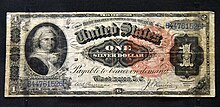
Silver dollar certificate banknote, U.s. Department of the Treasury, United states of america, 1886. On display at the British Museum in London
The first silver certificates (Series 1878) were issued in denominations of $10 through $ane,000.[nb iv] Reception past financial institutions was cautious.[25] While more convenient and less bulky than dollar coins, the silver certificate was non accepted for all transactions.[26] The Bland–Allison Act established that they were "receivable for community, taxes, and all public dues,"[20] and could exist included in bank reserves,[22] only silvery certificates were not explicitly considered legal tender for private interactions (i.e., betwixt individuals).[22] Congress used the National Banking Deed of July 12, 1882 to clarify the legal tender status of silver certificates[27] by conspicuously authorizing them to exist included in the lawful reserves of national banks.[28] A full general appropriations deed of 4 August 1886 authorized the issue of $1, $ii, and $5 silver certificates.[half dozen] [29] The introduction of low-denomination currency (every bit denominations of U.S. Notes under $five were put on concord) profoundly increased circulation.[30] Over the 12-year lifespan of the Bland–Allison Deed, the United states of america government would receive a seigniorage amounting to roughly $68 million (between $3 and $9 million per twelvemonth),[31] while absorbing over threescore% of U.Due south. silver production.[31]
Small-size silver certificates [edit]
Treasury Secretarial assistant Franklin MacVeagh (1909–13) appointed a committee to investigate possible advantages (e.g., reduced cost, increased production speed) to issuing smaller sized Us banknotes.[32] Due in office to the outbreak of Earth War I and the end of his appointed term, any recommendations may have stalled. On August 20, 1925, Treasury Secretarial assistant Andrew W. Mellon appointed a similar committee and in May 1927 accepted their recommendations for the size reduction and redesign of U.Southward. banknotes.[32] On July x, 1929 the new pocket-sized-size currency was issued.[33]
In keeping with the verbiage on big-size silver certificates, all the small-scale-size Series 1928 certificates carried the obligation "This certifies that there has (or take) been deposited in the Treasury of the United states 10 silver dollar(s) payable to the bearer on demand" or "10 dollars in silver money payable to the bearer on demand". This required that the Treasury maintain stocks of argent dollars to dorsum and redeem the silver certificates in circulation. Beginning with the Series 1934 silverish certificates the wording was changed to "This certifies that at that place is on deposit in the Treasury of the United States of America 10 dollars in silver payable to the bearer on demand." This freed the Treasury from storing numberless of silver dollars in its vaults, and allowed it to redeem silver certificates with bullion or silver granules, rather than silver dollars. Years after the government stopped the redemption of silver certificates for silver, large quantities of silvery dollars intended specifically to satisfy the earlier obligation for redemption in silver dollars were found in Treasury vaults.
As was usual with currency during this period, the year date on the beak did non reverberate when information technology was printed, simply rather a major design change. Under the Silver Purchase Act of 1934, the authority to result silvery certificates was given to the U.S. Secretary of Treasury.[34] Additional changes, particularly when either of the two signatures was contradistinct, led to a letter beingness added below the engagement. One notable exception was the Serial 1935G $1 silver document, which included notes both with and without the motto "In God Nosotros Trust" on the opposite. 1935 dated i dollar certificates lasted through the alphabetic character "H", after which new printing processes began the 1957 series.[35] In some cases printing plates were used until they wore out, even though newer ones were too producing notes, so the sequencing of signatures may not always exist chronological. Thus some of the 1935 dated 1 dollar certificates were issued as belatedly as 1963.[36]
Earth War II Issues [edit]
In response to the Japanese assault on Pearl Harbor, the Hawaii overprint note was ordered from the Bureau of Engraving and Printing on June viii, 1942 (all were made-over 1934–1935 bills).[33] Issued in denominations of $one, $five, $10, and $20, but the $1 was a silvery certificate, the others were Federal Reserve Notes.[37] Stamped "HAWAII" (in modest solid letters on the obverse and large letters on the contrary), with the Treasury seal and serial numbers in chocolate-brown instead of the usual blue, these notes could be demonetized in the consequence of a Japanese invasion.[38] Additional World State of war II emergency currency was issued in November 1942 for circulation in Europe and Northern Africa.[33] Printed with a bright yellow seal, these notes ($1, $5, and $10) could be demonetized should the United states of america lose its position in the European or Northward African campaigns.[37]
"Star notes" [edit]
When a neb is damaged in printing it is normally replaced past another 1 (the star replaces a alphabetic character at the edge of the note). To proceed the amounts issued consistent, these replacement banknotes are ordinarily indicated by a star in the separately sequenced serial number. For silverish certificates this asterisk appears at the starting time of the serial number.[39]
End of the silver certificates [edit]
In the virtually three decades since passage of the Silver Purchase Act of 1934, the annual demand for silverish bullion rose steadily from roughly 11 meg ounces (1933) to 110 one thousand thousand ounces (1962).[40] The Acts of 1939 and 1946 established floor prices for silver of 71 cents and ninety.v cents (respectively) per ounce.[twoscore] Predicated on an predictable shortage of silver bullion,[41] [42] Public Law 88-36 (PL88-36) was enacted on 4 June 1963 which repealed the Silver Buy Deed of 1934, and the Acts of July 6, 1939 and July 31, 1946,[43] while providing specific instruction regarding the disposition of silverish held as reserves against issued certificates and the price at which silvery may exist sold.[nb 5] It also amended the Federal Reserve Deed to authorize the issue of lower denomination notes (i.e., $1 and $2),[43] allowing for the gradual retirement (or swapping out procedure) of $ane silver certificates and releasing silverish bullion from reserve.[42] In repealing the before laws, PL88-36 also repealed the authority of the Secretary of the Treasury to control the result of silverish certificates. By issuing Executive Order 11110, President John F. Kennedy was able to proceed the Secretary'south potency.[44] While retaining their condition as legal tender, the silver certificate had effectively been retired from use.[33]
In March 1964, Secretary of the Treasury C. Douglas Dillon halted redemption of silver certificates for silver dollar coins; during the following four years, silver certificates were redeemable in uncoined argent "granules".[41] All redemption in silver ceased on 24 June 1968.[1] While there are some exceptions (particularly for some of the very early issues besides every bit the experimental bills) the vast bulk of pocket-size sized ane dollar silver certificates, particularly non-star or worn bills of the 1935 and 1957 serial, are worth fiddling or nix in a higher place their face values. They can however occasionally be found in apportionment.
Issue [edit]
Series and varieties [edit]
| Series | Value | Features/varieties |
|---|---|---|
| 1878 and 1880[nb 6] | $10 $20 $50 $100 $500 $i,000 | In addition to the 2 engraved signatures customary on Us banknotes (the Register of the Treasury and Treasurer of the U.s.), the offset event of the Series 1878 notes (similar to the early Gold Certificate) included a third signature of ane of the Assistant Treasurers of the United States (in New York, San Francisco, or Washington DC).[47] Known equally a countersigned or triple-signature note, this characteristic existed for the first run of notes issued in 1880, but was then removed from the remaining 1880 issues.[5] |
| 1886 | $1 $2 $5 $10 $20 | The Act of August iv, 1886 authorized the issue of lower denomination ($ane, $2, and $five) silver certificates.[half-dozen] Similar to the Series 1878/1880 notes, the Treasury seal characteristics (size, color, and mode) varies with the change of the Treasury signatures.[48] The serial is known for the ornate engraving on the reverse of the note. |
| 1891 | $1, $2 $five, $10 $xx, $50 $100 $1,000 | The Bureau of Engraving and Press introduced the process of "resizing" paper for Series 1891 notes.[49] |
| 1896 | $1 $ii $5 | The Educational Serial is considered to exist the most artistically designed bank notes printed by the U.s.a..[5] |
| 1899 | $1 $2 $five | Big-size silver certificates from the Series of 1899 frontwards have a blue Treasury seal and series numbers.[50] |
| 1908 | $ten | |
| 1923 | $ane $5 |
Big-size United states silver certificates (1878–1923) [edit]
| Value | Series | Fr.[nb 7] | Image | Portrait | Signature & seal varieties[nb 8] |
|---|---|---|---|---|---|
| $1 | 1886 | Fr.217 |  | Martha Washington | 215 – Rosecrans and Jordan – small-scale blood-red, patently 216 – Rosecrans and Hyatt – small-scale red, apparently |
| $1 | 1891 | Fr.223 | 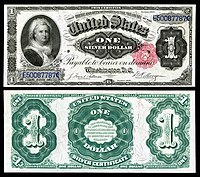 | Martha Washington | 222 – Rosecrans and Nebecker – small crimson, scalloped 223 – Tillman and Morgan – small cherry-red, scalloped |
| $one | 1896 | Fr.224 |  | Apologue History Instructing Youth (obv); George Washington & Martha Washington (rev) | 224 – Tillman and Morgan – small red, rays 225 – Bruce and Roberts – minor red, rays |
| $1 | 1899 | Fr.226 |  | Abraham Lincoln & Ulysses Grant | 226 – Lyons and Roberts – blue 227 – Lyons and Treat – blue |
| $1 | 1923 | Fr.239 |  | George Washington | 237 – Speelman and White – blue 238 – Wood and White – bluish |
| $two | 1886 | Fr.242 |  | Winfield Scott Hancock | 240 – Rosecrans and Jordan – pocket-size red 241 – Rosecrans and Hyatt – small red |
| $2 | 1891 | Fr.246 |  | William Windom | 245 – Rosecrans and Nebecker – small carmine 246 – Tillman and Morgan – minor red |
| $2 | 1896 | Fr.247 |  | Allegory of Science Presenting Steam and Electricity to Commerce and Industry (obv); Robert Fulton & Samuel F.B. Morse (rev) | 247 – Tillman and Morgan – small red 248 – Bruce and Roberts – small red |
| $two | 1899 | Fr.249 |  | George Washington | 249 – Lyons and Roberts – blueish 250 – Lyons and Treat – blue |
| $5 | 1886 | Fr.264 | 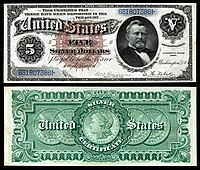 | Ulysses Grant | 259 – Rosecrans and Hashemite kingdom of jordan – pocket-size scarlet, plain 260 – Rosecrans and Hyatt – small red, plain |
| $v | 1891 | Fr.267 |  | Ulysses Grant | 266 – Rosecrans and Nebecker – small-scale red, scalloped 267 – Tillman and Morgan – small red |
| $5 | 1896 | Fr.270 |  | Allegory of Electricity Presenting Light to the World (obv); Ulysses Grant & Philip Sheridan (rev) | 268 – Tillman and Morgan – small red 269 – Bruce and Roberts – small ruby |
| $five | 1899 | Fr.271 | 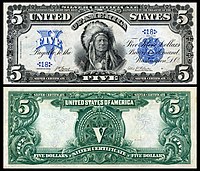 | Running Antelope | 271 – Lyons and Roberts – blue 272 – Lyons and Care for – blue |
| $5 | 1923 | Fr.282 |  | Abraham Lincoln | 282 – Speelman and White – blue |
| $10 | 1878 | Fr.285a* |  | Robert Morris | 283 – Scofield and Gilfillan, CS by West.M. White – large red 284 – Scofield and Gilfillan, CS past J.C. Hopper – large carmine |
| $10 | 1880 | Fr.287 |  | Robert Morris | 286 – Scofield and Gilfillan, CS by T. Hillhouse – large brown with X 286a – Scofield and Gilfillan, CS by A.U. Wyman – large brownish with X |
| $x | 1886 | Fr.291 |  | Thomas Hendricks | 291 – Rosecrans and Jordan – small red, plain 292 – Rosecrans and Hyatt – small red, plain |
| $x | 1891 | Fr.298 |  | Thomas Hendricks | 298 – Rosecrans and Nebecker – small scarlet 299 – Tillman and Morgan – minor red |
| $10 | 1908 | Fr.302 | 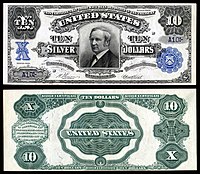 | Thomas Hendricks | 302 – Vernon and Treat – blueish 303 – Vernon and McClung – blueish |
| $twenty | 1878 | Fr.307 |  | Stephen Decatur | 305 – Scofield and Gilfillan, CS by J.C. Hopper – large carmine 306 – Scofield and Gilfillan, CS by T. Hillhouse – large red |
| $xx | 1880 | Fr.311 |  | Stephen Decatur | 308 – Scofield and Gilfillan, CS by T. Hillhouse – large brown 309 – Scofield and Gilfillan – large brownish |
| $20 | 1886 | Fr.316 | 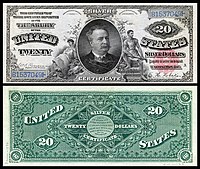 | Daniel Manning | 313 – Rosecrans and Hyatt – large cherry 314 – Rosecrans and Huston – large brown |
| $xx | 1891 | Fr.317 |  | Daniel Manning | 317 – Rosecrans and Nebecker – small red 318 – Tillman and Morgan – pocket-size cherry-red |
| $50 | 1878 | Fr.324 |  | Edward Everett | 323 – Scofield and Gilfillan, CS past Westward.C. White* or J.C. Hopper* – large red 324 – Scofield and Gilfillan, CS by T. Hillhouse – large red |
| $l | 1880 | Fr.327 |  | Edward Everett | 325 – Scofield and Gilfillan – big brown, rays 326 – Bruce and Gilfillan – large brown, rays |
| $50 | 1891 | Fr.331 | 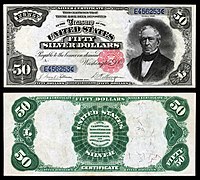 | Edward Everett | 330 – Rosecrans and Nebecker – small red 331 – Tillman and Morgan – small red |
| $100 | 1878 | Fr.337b | 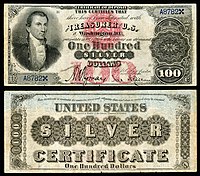 | James Monroe | 336 – Scofield and Gilfillan, CS past W.G. White – large cherry-red 336a – Scofield and Gilfillan, CS past J.C. Hopper or T. Hillhouse – big red |
| $100 | 1880 | Fr.340 |  | James Monroe | 338– Scofield and Gilfillan – big chocolate-brown, rays 339 – Bruce and Gilfillan – big brown, rays |
| $100 | 1891 | Fr.344 | 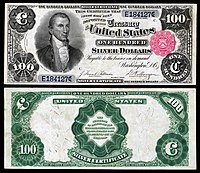 | James Monroe | 343 – Rosecrans and Nebecker – pocket-sized red 344 – Tillman and Morgan – small red |
| $500 | 1878 | Fr.345a | 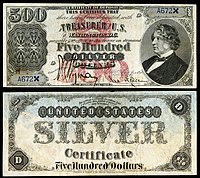 | Charles Sumner | 345a – Scofield and Gilfillan, CS past A.U. Wyman* – large red, rays |
| $500 | 1880 | Fr.345c |  | Charles Sumner | 345b – Scofield and Gilfillan – big brown 345c – Bruce and Gilfillan – large dark-brown |
| $1,000 | 1878 | Fr.346a | 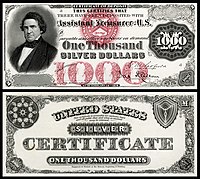 | William Marcy | 346a – Scofield and Gilfillan, CS unknown – large red, rays |
| $1,000 | 1880 | Fr.346d | 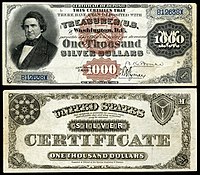 | William Marcy | 346b – Scofield and Gilfillan – large chocolate-brown 346c – Bruce and Gilfillan – large brown |
| $i,000 | 1891 | Fr.346e | 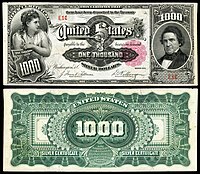 | William Marcy | 346e – Tillman and Morgan – modest red |
Small-size Us argent certificates (1928–1957) [edit]
| Value | Series | Fr.[nb 9] | Epitome | Portrait | Signature & seal varieties |
|---|---|---|---|---|---|
| $1 | 19281928 to 1928-E | Fr.1600 |  | George Washington | 1600 – Tate and Mellon (1928) – blue 1601 – Forest and Mellon (1928A) – blue[nb ten] |
| $1 | 19341934 | Fr.1606 |  | George Washington | 1606 – Julian and Morgenthau (1934) – blue |
| $1 | 19351935 to 1935-G | Fr.1607 |  | George Washington | 1607 – Julian and Morgenthau (1935) – blue 1608 – Julian and Morgenthau (1935A)– blue |
| $1 | 19571935-G to 1957-B | Fr.1619 |  | George Washington | 1617 – Smith and Dillon (1935G) – blue[nb 13] 1618 – Granahan and Dillon (1935H) – blue |
| $5 | 19341934 to 1934-D | Fr.1650 |  | Abraham Lincoln | 1650 – Julian and Morgenthau (1934) – blue 1651 – Julian and Morgenthau (1934A) – blue |
| $5 | 19531953 to 1953-C | Fr.1655 | 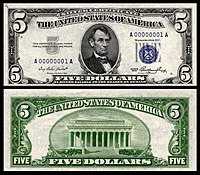 | Abraham Lincoln | 1655 – Priest and Humphrey (1953) – blue 1656 – Priest and Anderson (1953A) – blue |
| $10 | 19331933 to 1933-A | Fr.1700 |  | Alexander Hamilton | 1700 – Julian and Woodin (1933) – blue[nb 15] 1700a – Julian and Morgenthau (1933A) – bluish[nb xiv] |
| $10 | 19341934 to 1934-D | Fr.1701 | 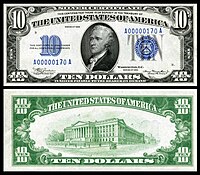 | Alexander Hamilton | 1701 – Julian and Morgenthau (1934) – bluish 1702 – Julian and Morgenthau (1934A) – blue |
| $x | 19531953 to 1953-B | Fr.1706 | 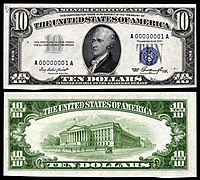 | Alexander Hamilton | 1706 – Priest and Humphrey (1953) – blue 1707 – Priest and Anderson (1953A) – blue |
| $1 | 1935-A1935-A | Fr.2300 | 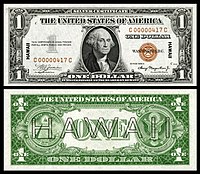 | George Washington | 2300 – Julian and Morgenthau – brown |
| $1 | 1935-A1935-A | Fr.2306 |  | George Washington | 2306 – Julian and Morgenthau (1935A) – yellow |
| $5 | 1934-A1934-A | Fr.2307 | 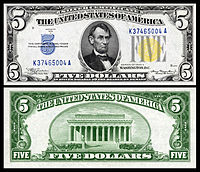 | Abraham Lincoln | 2307 – Julian and Morgenthau (1934A) – yellow |
| $x | 1934-A1934 to 1934-A | Fr.2309 | 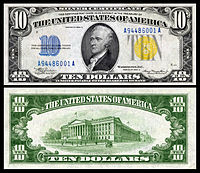 | Alexander Hamilton | 2308 – Julian and Morgenthau (1934) – yellow 2309 – Julian and Morgenthau (1934A) – yellow |
Come across also [edit]
- Aureate certificate
- Silver as an investment
- Silver certificate (Republic of cuba)
- Silver standard
Explanatory footnotes [edit]
- ^ Large size notes represent the earlier types or serial of U.S. banknotes. Their "boilerplate" dimension is 7.375 × 3.125 inches (187 × 79 mm). Small size notes (described every bit such due to their size relative to the before large size notes) are an "average" 6.125 × two.625 inches (156 × 67 mm), the size of modern U.Southward. currency. "Each measurement is +/- 0.08 inches (2mm) to account for margins and cutting".[3]
- ^ Some have suggested that the bimetallic standard was actually initiated by Thomas Jefferson.[fourteen]
- ^ Although the exact monthly purchase was left to the discretion of the Secretary of the Treasury, the $two 1000000 minimum was never exceeded.[23]
- ^ "The act of Feb 28, 1878, also authorized the holder of these argent dollars to deposit: the same with the Treasurer, or whatsoever Banana Treasurer, of the United states of america, in sums non less than ten dollars, and receive therefor certificates of non less than ten dollars each, respective with the denominations of the United States notes."[24]
- ^ "SEC. 2. The Secretary of the Treasury shall maintain the ownership and the possession or control inside the United States of an amount of silver of a monetary value equal to the face amount of all outstanding silver certificates. Unless the market price of silverish exceeds its monetary value, the Secretarial assistant of the Treasury shall not dispose of any silver held or owned by the United States in excess of that required to be held every bit reserves against outstanding silver certificates, but any such excess silvery may be sold to other departments and agencies of the Government or used for the coinage of standard silver dollars and subsidiary silver coins. Silver certificates shall be exchangeable on demand at the Treasury of the U.s.a. for silver dollars or, at the choice of the Secretary of the Treasury, at such places as he may designate, for silvery bullion of a monetary value equal to the face amount of the certificates".[43]
- ^ Notes issued under a given Serial (east.thou., Series 1880, Serial 1899) are, in some cases, released over a period of years, as reflected in the Friedberg number signature and seal varieties. For instance, based on dates of the signature combinations,[46] the Serial 1899 $one silver certificate was first issued with the signature combination of Lyons and Robert (in role together from 1898 to 1905) and terminal issued with the Speelman and White signatures (in office together from 1922 to 1927). Therefore, a Serial 1899 note could have been issued as tardily every bit 1927.
- ^ "Fr" numbers refer to the numbering organisation in the widely used Friedberg reference book. Fr. numbers indicate varieties existing within a larger type design.[48]
- ^ Varieties are presented by Fr. number followed by the specific differences in signature combination, seal (colour, size, and manner), and minor pattern changes, if applicative. For Series 1878 notes, an asterisk post-obit the Assistant Treasurer'south name indicates it is paw-signed versus engraved.
- ^ Because small-size silver certificates are presented in ascending Friedberg number, World War II emergency consequence notes (2300, 2306, 2307, and 2309) are presented out of chronological order at the end of the tabular array.
- ^ Serial blocks of the 1928A and 1928B silver certificates that were lettered XB or YB were made of experimental newspaper, and ZB of regular newspaper as a control.[53]
- ^ Serial 1935A "Experimental" bills were stamped with either a red "R" or "Due south" while testing regular and constructed papers.[8]
- ^ For 1935D, narrow and wide refer to the width of pattern features on the reverse of the annotation. The wide variety is 0.0625 in (1.5875 mm) larger and has a iv-digit opposite plate number less than 5016.[54]
- ^ The motto ("In God We Trust") was added to the Series of 1935G notes midway through the consequence.[8]
- ^ a b Printed only not issued.[55]
- ^ Very few Series 1933 $x Argent Certificates were released before they were replaced past Series 1934 and nigh of those remaining were consigned to destruction; only a few dozen are known to collectors today.[56]
Citations [edit]
- ^ a b c d "Argent Certificates". Agency of Engraving and Printing/Treasury Website. Archived from the original on 3 April 2014. Retrieved 12 Feb 2014.
- ^ a b Leavens, p. 24.
- ^ Friedberg & Friedberg, p. 7.
- ^ Blake, p. eighteen.
- ^ a b c d Friedberg & Friedberg, p. 74.
- ^ a b c Knox, p. 155.
- ^ Friedberg & Friedberg, p. 185.
- ^ a b c Friedberg & Friedberg, p. 187.
- ^ Friedman, p. 1166.
- ^ O'Leary, p. 392.
- ^ a b Barnett, p. 178.
- ^ Friedman, p. 1165.
- ^ Lee, p. 388.
- ^ Carothers, p. 5.
- ^ O'Leary, p. 388.
- ^ Leavens, p. 36.
- ^ Taussig, 1892, p. 11.
- ^ Leavens, p. 38.
- ^ Lee, p. 393.
- ^ a b Lee, p. 396.
- ^ Agger, p. 262.
- ^ a b c Knox, p. 153.
- ^ Taussig, 1892, p. eight.
- ^ Knox, p. 152.
- ^ Taussig, 1892, p. xv.
- ^ Taussig, 1892, p. 10.
- ^ Taussig, 1892, p. 16.
- ^ Champ & Thomson, p. 12.
- ^ McVey, p. 438.
- ^ Champ & Thomson, p. 14.
- ^ a b Leavens, p. 39.
- ^ a b Schwartz & Lindquist, p. 9.
- ^ a b c d "BEP History". Bureau of Engraving and Printing/ Treasury Website. Archived from the original on fourteen January 2014. Retrieved fourteen February 2014.
- ^ https://www.loc.gov/law/assistance/statutes-at-big/73rd-congress/session-ii/c73s2ch674.pdf[ blank URL PDF ]
- ^ Series of 1935 $one Silver Certificate - Values and Pricing Archived 2014-05-07 at the Wayback Machine
- ^ Delivery Dates by Series
- ^ a b Schwartz & Lindquist, p. 24.
- ^ Cuhaj, p. 133.
- ^ A Guide To Values and Pricing for Star Notes Archived 2013-eleven-26 at the Wayback Car
- ^ a b Dillon, p.401.
- ^ a b Ascher, p. 99.
- ^ a b Dillon, p.400.
- ^ a b c Public Law 88-36 (An Act to repeal certain legislation relating to the purchase of argent, and for other purposes) (PDF) (Study). U.S. Government Printing Office. 1963. Retrieved 14 February 2014.
- ^ Grayness, p. 83.
- ^ Friedberg & Friedberg, pp. 70–90 and 188–90.
- ^ Friedberg & Friedberg, p. 303.
- ^ Blake, p. 19.
- ^ a b Friedberg & Friedberg, pp. half-dozen–7.
- ^ Annual Written report of the Secretary of the Treasury on the State of the Finances (Report). United States Department of the Treasury. 1892. p. 475. Retrieved 16 Feb 2014.
- ^ Friedberg & Friedberg, pp. 74–81.
- ^ Friedberg & Friedberg, pp. lxx–90.
- ^ Friedberg & Friedberg, pp. 188–ninety.
- ^ Schwartz & Lindquist, p. 31.
- ^ Friedberg & Friedberg, p. 170.
- ^ Friedberg & Friedberg, p. 190.
- ^ Schwartz & Lindquist, p. 156.
General references [edit]
- Agger, Eugene E. (1918). "The Denominations of the Currency". The Quarterly Journal of Economic science. 32 (2): 257–277. doi:x.2307/1885428. JSTOR 1885428.
- Ascher, Leonard Westward. (1964). "The Coming Chaos in Our Coinage". Financial Analysts Periodical. xx (3): 99–102. doi:10.2469/faj.v20.n3.99. JSTOR 4469657.
- Barnett, Paul (1964). "The Criminal offence of 1873 Re-examined". Agricultural History. 38 (iii): 178–181. JSTOR 3740438.
- Blake, George Herbert (1908). United States paper money. George H. Blake. p. 32. Retrieved xiii March 2014.
- Carothers, Neil (1932). "A Senate Racket". The Due north American Review. 233 (one): 4–15. JSTOR 25113955.
- Cuhaj, George South. (2012). Standard Itemize of The states Newspaper Coin. Krause Publications. ISBN978-1-4402-3087-five . Retrieved 14 February 2014.
- Dillon, C. Douglas (1963). Annual Report of the Secretary of the Treasury on the State of the Finances (Report). U.s.a. Government Printing Office. pp. 400–403.
- Friedberg, Arthur Fifty.; Friedberg, Ira South. (2013). Newspaper Money of the United States: A Complete Illustrated Guide With Valuations (20th ed.). Money & Currency Found. ISBN978-0-87184-520-7 . Retrieved 14 Feb 2014.
- Friedman, Milton (1990). "The Law-breaking of 1873". Periodical of Political Economy. 98 (6): 1159–1194. doi:x.1086/261730. JSTOR 2937754. S2CID 153940661.
- Grey, George B. (2002). Federal Reserve System: Background, Analyses and Bibliography. Nova Scientific discipline Publishers, Inc. ISBN978-one-59033-053-i . Retrieved fourteen February 2014.
- Knox, John Jay (1888). United States Notes: A history of the various issues of paper coin past the government of the United States (3rd ed.). Charles Scribner'due south Sons.
- Leavens, Dickson H. (1939). Silver Money. Principia Printing, Inc. Retrieved xiii February 2014.
- Lee, Alfred E. (1886). "Bimetalism in the United States". Political Scientific discipline Quarterly. 1 (3): 386–399. doi:10.2307/2139359. JSTOR 2139359.
- McVey, Frank L. (1902). "The Reclassification of the Newspaper Currency". Periodical of Political Economy. 10 (3): 437–442. doi:10.1086/250857. JSTOR 1819565.
- O'Leary, Paul M. (1960). "The Scene of the Crime of 1873 Revisited: A Note". Periodical of Political Economy. 68 (iv): 388–392. doi:10.1086/258345. JSTOR 1830011. S2CID 153797690.
- Schwartz, John; Lindquist, Scott (2011). Standard Guide to Small-scale-Size U.S. Paper Money – 1928 to Appointment. Krause Publications. ISBN978-1-4402-1703-half dozen . Retrieved fourteen Feb 2014.
- Taussig, F.W. (1890). "The Silvery State of affairs in the Usa". The Quarterly Journal of Economics. iv (3): 291–315. doi:10.2307/1881888. hdl:2027/uc1.$b245353. JSTOR 1881888.
- Taussig, F.W. (1892). "The Silvery Situation in the The states". Publication of the American Economic Clan. 7 (i): 7–118. JSTOR 2485709.
Further reading [edit]
- Hessler, Gene; Chambliss, Carlson (2006). The Comprehensive Catalog of U.S. Paper Money: All United States Federal Paper Money Since 1812 (7th ed.). BNR Press. ISBN9780931960666.
- National Monetary Committee (1910). Laws of the United states concerning money, banking, and loans, 1778–1909. Government Printing Function. Retrieved 14 Feb 2014.
External links [edit]
- Agency of Engraving and Printing
- U.Due south. Department of the Treasury
- USPaperMoney.Info
Source: https://en.wikipedia.org/wiki/Silver_certificate_(United_States)
Posted by: thompsoncuposer75.blogspot.com


0 Response to "What Is A Registered Blue And Silvler Stamp"
Post a Comment